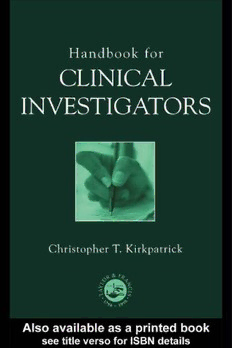
Handbook for clinical investigators PDF
Preview Handbook for clinical investigators
Handbook for Clinical Investigators Handbook for Clinical Investigators CHRISTOPHER T.KIRKPATRICK, BSc, MD, MFPM Associate Director, Phase I Research Chiltern International UK Taylor & Francis Ltd, 1 Gunpowder Square, London, EC4A 3DE USA Taylor & Francis Inc., 325 Chestnut Street, Philadelphia, PA 19106 This edition published in the Taylor & Francis e-Library, 2003. Copyright © C.T.Kirkpatrick 1999 All rights reserved. No part of this publication may be reproduced, stored in a retrieval system, or transmitted in any form or by any means, electronic, electrostatic, magnetic tape, mechanical, photo- copying, recording or otherwise, without the prior permission of the copyright owner. British Library Cataloguing-in-Publication Data A catalogue record for this book is available from the British Library. ISBN 0-203-48407-X Master e-book ISBN ISBN 0-203-79231-9 (Adobe eReader Format) ISBN 0-7484-0712-X (paper) Library of Congress Cataloging-in-Publication Data are available Cover design by Jim Wilkie Every effort has been made to ensure that the advice and information in this book is true and accurate at the time of going to press. However, neither the publisher nor the author can accept any legal responsibility or liability for any errors or omissions that may be made. In the case of drug administration, any medical procedure or the use of technical equipment mentioned within this book, you are strongly advised to consult the manufacturer’s guidelines. Contents Preface page ix 1 Motivation: What’s in it for me? 1 1.1 How we got there: approach by a sponsor 2 1.2 How we got there: approach by the potential investigator 3 1.3 Mission-driven or curiosity-driven research 3 1.4 Rewards 4 1.4.1 Cash 4 1.4.2 Reputation and publication 5 1.5 The main task of the clinical investigator 5 1.6 The team approach 5 2 Brief overview of drug development 7 2.1 Pre-clinical 7 2.2 Clinical 10 2.3 Drug registration procedures 10 3 Regulators and the Good Clinical Practice guidelines 11 3.1 The Good Clinical Practice directives 11 3.1.1 Protection of the subject 11 3.1.2 Protection of the data 12 3.1.3 European vs. USA requirements 12 v vi CONTENTS 3.2 Ethical issues 13 3.2.1 Declaration of Helsinki 13 3.2.2 Investigator 14 3.2.3 Protocol design 14 3.2.4 Ethics committee 14 3.2.5 Temptations in an investigator’s life 16 3.3 The duties of an investigator 17 3.3.1 The principal investigator 18 3.4 The clinical trial subject 19 3.4.1 The doctor-patient relationship is preserved 19 3.4.2 Informed consent 20 3.5 Standard operating procedures 22 3.5.1 The sponsor’s SOPs 22 3.5.2 The contract research organisation’s SOPs 22 3.5.3 Your own SOPs (you should have some!) 23 3.5.4 Compliance 23 4 The sponsor 25 4.1 The project team 25 4.2 The monitor 26 4.2.1 Source document verification 27 4.3 Audit 27 4.4 The contract 28 4.4.1 Financial details 28 4.4.2 What the sponsor will provide 30 4.4.3 What the investigator will provide 30 4.4.4 Confidentiality 31 4.5 The protocol 32 4.6 Structure 34 4.6.1 Introduction 34 4.6.2 Subject population 34 4.6.3 Description of test articles (i.e. drugs) 34 4.6.4 Procedures and methods 34 4.6.5 Statistical and analytical methods 35 4.6.6 Ethical and GCP issues 35 4.6.7 Administrative issues 35 5 Practical issues—running the trial 37 5.1 Time 37 5.2 Space 38 CONTENTS vii 5.3 Staffing 38 5.3.1 The study site coordinator 38 5.4 Communication 40 5.4.1 Face-to-face conversations 41 5.4.2 Telephone 41 5.4.3 Meetings 41 5.4.4 Facsimile transmission and electronic mail 41 5.4.5 Letters 42 5.5 Training 42 5.6 Documents 44 5.6.1 The investigator site file 44 5.6.2 The investigator’s brochure 44 5.6.3 The curriculum vitae 45 5.6.4 The clinical files (patient notes) 45 5.6.5 The case report form 47 5.6.6 Error correction 48 5.6.7 Dealing with data queries 48 5.7 The drugs—storage and care 50 5.7.1 The randomisation code 50 5.7.2 Breaking the code 51 5.8 How to cope with problems or disasters 51 5.8.1 Adverse events (AEs) 51 5.8.2 Serious adverse events (SAEs) 52 5.8.3 Operational problems 53 6 Publication 55 6.1 By the investigator 55 6.2 By the sponsor 56 6.3 The investigator’s duty to publish 57 6.4 The issue of authorship 58 Postscript 59 Glossary and list of abbreviations 61 Notes 71 Index 73 Preface This book is aimed at potential clinical investigators, especially those thinking about doing clinical trials to evaluate new drugs. It is the attempt by one clinical investigator to share his experiences and insights, in the hope that others who might be attracted to the role of investigator can share in the excitement of clinical research while avoiding some of the pitfalls that inevitably beset the newcomer to clinical trials. I have drawn upon my experiences as a research physician working first in a university, then in a government research institute, then in the mainstream pharmaceutical industry and a number of contract clinical research organisations. Most of my experience has been in the Phase I testing of drugs on healthy volunteers, but I have also seen a wide range of other types of interaction between sponsor and investigator, and between investigator and research subject (patient or volunteer). I believe I understand what the sponsor is looking for in a potential investigator, and also how an investigator can get the best out of his sponsor! Several books1 are available which act as introductions to clinical research, and most contain sections relevant to the clinical investigator. They are largely distillations of the Good Clinical Practice guidelines as they apply to investigators, but are usually written from the point of view of the clinical trials manager or monitor. They try to explain the regulations to doctors in the hope of eliciting correct behaviour from them. I hope in this book to go beyond this, offering insights into what it means to be an investigator, and giving hints on how to survive in the jungle of Good Clinical Practice. In some places in this book, persons fulfilling certain roles are referred to with either masculine or feminine pronouns. This is not to suggest that ix
